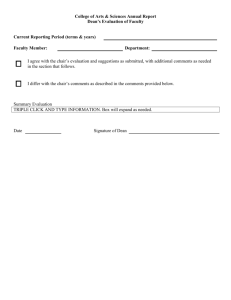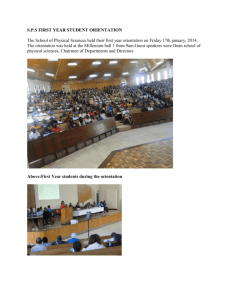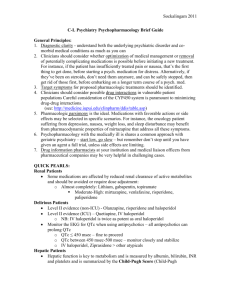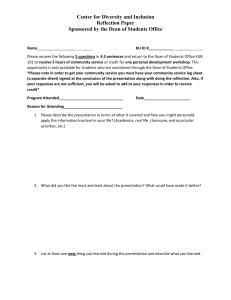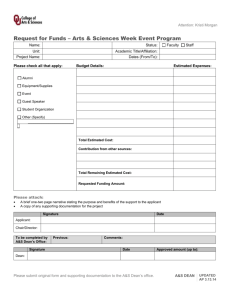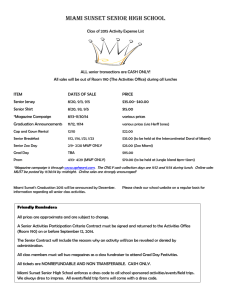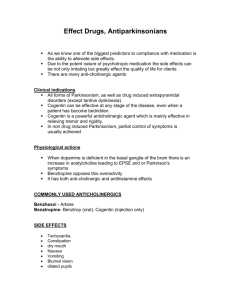Burton J. Goldstein by Thomas A. Ban
advertisement
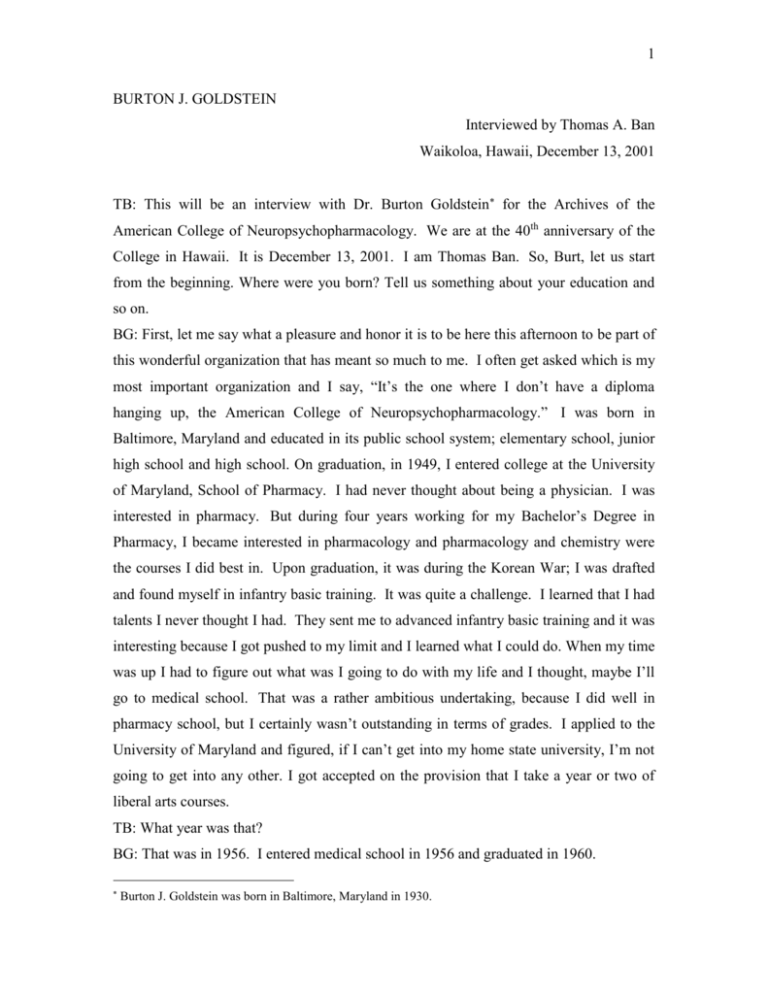
1 BURTON J. GOLDSTEIN Interviewed by Thomas A. Ban Waikoloa, Hawaii, December 13, 2001 TB: This will be an interview with Dr. Burton Goldstein for the Archives of the American College of Neuropsychopharmacology. We are at the 40th anniversary of the College in Hawaii. It is December 13, 2001. I am Thomas Ban. So, Burt, let us start from the beginning. Where were you born? Tell us something about your education and so on. BG: First, let me say what a pleasure and honor it is to be here this afternoon to be part of this wonderful organization that has meant so much to me. I often get asked which is my most important organization and I say, “It’s the one where I don’t have a diploma hanging up, the American College of Neuropsychopharmacology.” I was born in Baltimore, Maryland and educated in its public school system; elementary school, junior high school and high school. On graduation, in 1949, I entered college at the University of Maryland, School of Pharmacy. I had never thought about being a physician. I was interested in pharmacy. But during four years working for my Bachelor’s Degree in Pharmacy, I became interested in pharmacology and pharmacology and chemistry were the courses I did best in. Upon graduation, it was during the Korean War; I was drafted and found myself in infantry basic training. It was quite a challenge. I learned that I had talents I never thought I had. They sent me to advanced infantry basic training and it was interesting because I got pushed to my limit and I learned what I could do. When my time was up I had to figure out what was I going to do with my life and I thought, maybe I’ll go to medical school. That was a rather ambitious undertaking, because I did well in pharmacy school, but I certainly wasn’t outstanding in terms of grades. I applied to the University of Maryland and figured, if I can’t get into my home state university, I’m not going to get into any other. I got accepted on the provision that I take a year or two of liberal arts courses. TB: What year was that? BG: That was in 1956. I entered medical school in 1956 and graduated in 1960. Burton J. Goldstein was born in Baltimore, Maryland in 1930. 2 TB: So, you did not pursue a career as a pharmacist? BG: I never did. The pharmacy helped me, financially, to get through school. There was the GI Bill and I was getting, I think, a hundred and eighty dollars a month but I had to pay tuition out of that and everything else. As a pharmacist, I could work in the summers in the pharmacy and I made all of two dollars an hour, but I worked sixty or seventy hours a week and made a hundred and twenty or a hundred and thirty dollars. In 1956 that was a lot of money. So, I was able to pay for medical school. My GI Bill ran out, as I recall, at the end of my junior year but I got a scholarship for my last year of medical school. I graduated in 1960, and, like most of us, was trying to decide what path I should go. My role models were some of the people in the department of psychiatry; so I decided to go into psychiatry and went to Miami to do my internship, then applied to Jackson Memorial Hospital, a large community hospital of the University of Miami, for residency. I had an NIMH Fellowship during my residency years, so I took off in more of a research direction. But our program didn’t encourage research, because we were a county hospital. At that time, south Florida, particularly Miami, was undergoing a lot of turmoil and transition because of Cuba. Castro had just come in the late fifties and early sixties. I was there in 1960 and 1961, as an intern and from 1961 through 1964 as a resident. At that time there were a tremendous number of well qualified Cubans there because of the persecution. That went on for several years and the population of Dadecounty served by the hospital was exploding. So our clinical work overshadowed almost anything else. Everybody was so involved in patient care that research was put on the back burner. But I persisted and I was able to get involved during my second and third years with folks doing psychological research. I don’t even remember what they were doing but I learned some research strategies, research methodology that helped me. In 1964, I finished my training and our Professor and Chairman, John Caldwell said, “You know, if you’re interested in research, why don’t you stay on”? I was flattered and honored. So, I was able to join the faculty and I remember him telling me, “Well, I’m going to be able to pay you ten thousand dollars a year. That will be your salary and for seeing patients, you’ll get another ten thousand dollars”. I had never heard of that much money in my life, so I thought I was going to be a very, very wealthy person, not just having an opportunity of to become involved in research. Then I met some of the people 3 at the Psychopharmacology Service Center, which included you, your dear friend and colleague, Heinz Lehmann as well as Jon Cole and George Crane. By that time we had already done a couple of studies with haloperidol and when I started talking to George, he said, “You know, not too many people in the country have much experience with haloperidol, would you like to get involved in a study”? That was flattering, because I didn’t know very much about federal grants or anything of that sort and so George, as obsessive he was, and he really was obsessive, put a protocol together. It was a wonderful learning experience. It was a duplication, on a small scale, of the nine hospital collaborative study, the pivotal study in determining that neuroleptic drugs were effective in the treatment of schizophrenia which was completed in 1962. TB: After completing your residency you stayed on the faculty of the Department of Psychiatry at the University of Miami. Didn’t you have something published while still a resident? BG: Right. I began publishing while I was still a resident. Our first paper was on Cogentin (benzotropine mesylate.) It addressed whether it should be used before EPS developed or after the first signs. It was a terrible paper and it was rejected by a couple of journals before, finally, it got accepted. TB: So, your interest was in clinical pharmacology? BG: It was something that caught my interest, even though I didn’t know any people in the field, and I was fortunate to have opportunities to pursue it. TB: How did you get involved with the Cogentin study? BG: That came from watching patients develop EPS, who were on Trilafon (perphenazine) and Stelazine (trifluoperazine) They were taking high doses and developed extrapyramidal side effects. But what really triggered it, now that you ask me the question, was that when I was an intern, a man came into the emergency room and his jaws were locked. Everybody thought he had tetanus, but when I asked him to write out what medications he was taking, he had been on Trilafon or Stelazine. He was having a dystonic reaction. There are very few times in my life I’ve been called a hero, but the people in the emergency room thought I was really smart, especially when I gave the man one or two milligrams of Cogentin IV, and he could talk again. Gosh, I could walk on water that day! That may have been behind the Cogentin study. 4 TB: Could you say something about the study? BG: I don’t remember the results clearly but I think it was that you could not predict who was going to get EPS, so it probably wasn’t worthwhile giving Cogentin prophylactically. I learned research methodology from the study, and that was the beginning. TB: Did you do any other studies while a resident? BG: No, at that time I was working with a psychologist doing research in some abstract field so that was the only pharmacological work I did as a resident. The University of Miami was only about ten years old and the Department of Psychiatry had only four full time psychiatrists. It was a very young department trying to take care of enormous numbers of indigent patients; the clinical load overshadowed everything. That takes us up to about 1964 and meeting George Crane, who helped us to design the haloperidol study. I was fortunate that along the way I met Dean Clyde who had come to Miami a couple of years before, to set up the biometric lab at the University. The teaching hospital is in the center of the city and the University is on what’s known as the Coral Gables campus, sixteen miles from where Dean’s shop was set up. Dean was a unique individual. He was, in many ways, a loner, but Dean and I had a rapport that was wonderful. We had a close and not just professional relationship. What impressed me about Dean was not only his dedication but his abilities. He set up this biometric lab on the forth floor of a brand new building that was half of the size of a Costco warehouse with a whole floor for all of Dean Clyde’s computers. That was just overwhelming and I got to work with him on the Cuban refugees. When the refugees were coming into Miami, they would come to what was known as Freedom Tower where they had all kinds of social service support. Dean was asked by the state department or someone to administer the Clyde Mood Scale to these people. One of the humorous events was, when Dean Clyde said, “You know, all these Cubans are coming and the scale is in English. We need to translate it”. So, I got one of my faculty members, who had just come over from Cuba, to translate the scale. He was a very erudite physician, trained in Boston. He knew English and he knew Spanish and he translated the Clyde Mood Scale into Spanish, but none of the people coming over could understand his upper class Spanish. Then we found a person of lower social status but no one could understand him either. Finally, we were able to find a 5 social worker who succeeded. When we started our haloperidol work with George Crane, Dean was part of setting up the design. I wish I had the slides from that study. It would be fun to look back now, thirty-five years later. We could keep patients in the hospital for three months. Today, we keep people in the hospital for four days. But then we had a design in which patients were treated with Haldol or Trilafon in a blinded design for eight weeks. At the end of eight weeks, we’d have a clinical conference and if they were considerably improved, we would watch them for another eight weeks. But if they relapsed, they would be started on the drug they improved on. But, at the end of eight weeks, if they didn’t improve, they were crossed over to the other drug and treated for another eight or sixteen weeks. At the end of the study we found haloperidol was an effective neuroleptic drug, which sounds foolish today, just as the nine hospital study sounds foolish today, because everybody assumes we always knew those drugs were very effective. The most interesting part of that study was that, at the end, we could firmly conclude that the dose of haloperidol should be fifteen to twenty milligrams a day. I remember that Dick Shader from Boston called me and asked, “Burt, what is the dose of haloperidol”? And, I said, “Dick, it’s sixteen to twenty mg. a day, you don’t have to go up to those megadoses”. What actually happened was sort of an industry push. They talked about rapid tranquilization, but rapid tranquilization really translated to rapid haldolization. So, a lot of Haldol was sold; people didn’t need ninety milligrams of Haldol, twenty mgs was just as good. TB: Today, you could go even lower. BG: Sure. We were particularly honored because the introduction of haloperidol, once it was approved by the FDA, took place in Miami. We had a symposium and Paul Janssen was there. At the same time, we were starting several industry sponsored clinical studies. Then, I wrote with Dean Clyde, the chapter on the butyrophenones in ACNP’s Psychopharmacology, A review of Progress from 1957 to 1967. We put John Caldwell’s name in as a third author because he was always a tremendous support. TB: So you did your research with haloperidol in collaboration with Dean Clyde? BG: Yes. I think Dean was probably the person who got that study for us, because I was unknown and Dean was a known entity; he certainly deserves the credit. TB: It seems that study was very important in your career? 6 BG: I was fortunate because I began to meet a lot of people. I met Nina Schooler, Jonathan Cole, Arnold Friedhoff, Ronnie Lippman and Jerry Levine to name a few. The two people I worked closest with were Leo Hollister and Bert Schiele. They were not only, professional but close personal friends. Yesterday, at the memorial services, my eyes welled up. I just thought about Leo and what a tremendous human being and wonderful man he was. I knew him so well in a very personal way along with his son, Matt, who was somewhat autistic and schizophrenic, and how Leo took care of that child. That young man would have never survived if it was not for Leo’s nurturing; that was another side of him. I’ve been so blessed to be able to work with so many wonderful people. TB: Let’s get back to chronology. Are we now in the late 1960s? BG: We are into 1967 and we were watching a lot of Karl Rickel's work because our hospital was similar to Karl’s hospital, the Pennsylvania Hospital that had a large indigent population. We became aware, as did Karl Rickels, that there were influences to drug response and side effects that went beyond and outside the pharmacology of drugs. As an example, if you had a lower socioeconomic group of people that were on welfare, and did not need to get to work in the morning, they didn’t object to the sedative side effects of a drug, as much as a middle class person, who had to get up and go to work. To overcome this problem Karl Rickles was fortunate to get primary care physicians as part of his network. He had a cadre of both indigent and private practice patients, thus he could study the same drugs across these groups to have a better sense of what the efficacy and side effects might be in different populations. We tried hard to replicate what Karl did but we couldn’t do it and ultimately came up with the idea to recruit symptomatic volunteers, a population similar in socioeconomic factors to private patients and the question was whether these subjects had similar levels of “psychopathology” as Karl’s patients. We worked with Leo Hollister and John Overall evaluating three study groups; one, an indigent population, second, a private practice population, and third, a “symptomatic volunteer” population that we get recruited via public notice. We designed a study to evaluate the efficacy and side effect profiles in these three groups and also we obtained demographic and sociologic data so that we could not only determine response 7 to treatment but also find out if the “Symptomatic volunteers” (SVs) were more similar in their response to the indigent or private practice patients. TB: When was that? BG: We began this work in 1968 with a grant to study the symptomatic volunteers and where they fell into the spectrum. And, as it turned out, our hypothesis was accurate that these subjects were socioeconomically similar to the private practice patient in their response to medication. Our group were the first to utilize this SV population for drug studies. This morning, I asked Paul Leber of the FDA, “Paul, how can I find out how many drug trials have been done since 1970, using recruited subjects”? And, he said, “I have no idea; you’d have to ask the drug companies”. Obviously, they don’t have any idea either, but I would imagine that, just not in our field of psychiatry, but also in other medical disciplines you can find many studies done with symptomatic volunteers, recruited by advertising in newspapers or TV. I am very proud of our work because the use of symptomatic volunteers has facilitated clinical drug development across the world. I doubt that there would be enough patients to conduct most medication clinical trials without the use of symptomatic volunteers. I believe this work has facilitated drug development and I feel very good about that. TB: So, the idea of working with symptomatic volunteers comes from you? BG: I published on it first in 1970. As I look back on my career, that’s probably my greatest contribution because it certainly facilitated drug development and drug discovery. TB: By that time you attended, quite regularly, the annual ECDU meetings, right? Besides the grant for the haloperidol study, you also had a grant from NIMH. Is there any other area of research you had been involved with? BG: We were doing a lot of drug trials, but then we became aware of was the flip side of psychopharmacology, substance abuse. There was a Catholic Priest in the Miami area, Monsignor Brian Walsh, who came to see Jim Sussex, the Chairman of our department and myself, telling us, “You know, we’re having problems with our methadone clinics. Msg. Walsh felt that many of the Methadone patients were depressed and the methadone treatment alone was not helping their depression. He asked if we would look into this. I reviewed some of Freud’s early literature on the use of Cocaine to treat “melancholia.” 8 We believed that one could make a pretty good case that many individuals that got hooked onto heroin, cocaine or other drugs were trying to treat themselves for depression. I remember talking to Mitch Balter about this at NIMH and we submitted a grant proposal to NIDA to study this question. Our thinking was that some of these individuals were not adequately treated, because nobody was treating their depression. So, we set up a Methadone Clinic, under the auspices of Monsignor Walsh. In the study when someone came into the methadone program, we assessed their depression on the Hamilton Scale and four or five weeks later, we would repeat it. Those patients whose Hamilton scores indicated moderate or severe depression were randomly assigned to one of two treatment groups; half the group was treated with methadone plus an antidepressant and the other group with methadone and placebo. Patients received medication daily in a 12 week double blind study. At the end of the study there were decreases in depression scores. However, the greatest change observed was in the patients’ behavior. They seemed to get into less trouble with police. There was a great deal of improvement, mainly in the area of behavior, fewer arrests, improvement in relationships etc. If you follow the literature on heroin addicts and methadone programs, there is a body of literature which has been emerging over the years that these individuals may respond to antidepressants plus their medication, because of underlying depression. While we were doing this study there was a young man from Yale, looking to get involved in psychopharmacology. I was able to obtain a career teacher award from NIDA for him. He seemed to have a real interest in a teaching and research career. The young man’s name is Brian Weiss, and one day I asked him, “Brian, would you be interested in an academic career and he said, “Yes”. Then we put a grant together with me as PI and Brian as a Career Teacher and we got the grant for three years. In the second year of the grant, Brian came to me and said, “You know, I don’t think this is really what I want to do. I have an opportunity to go over to the Mt. Sinai Hospital where they are going to start a Department of Psychiatry”. Mt. Sinai is a private hospital in Miami Beach, a very well funded hospital with about six hundred beds. It is very different from the Jackson Hospital, which cares primarily, for indigent patients. I said, “If that’s what you want, I wish you the best of luck”. So, Brian went to Mt. Sinai and begins to see a lot of private patients. The next thing I know, Brian is involved in past life therapy and writes a book,” Many Masters, Many Lives”, and 9 became very, very famous. Now, there’s about a year waiting list for patients to see him and his charge is about five hundred dollars an hour to take you back into a life you may have had before. While it was a disappointment for us, it gave Brian Weiss stardom and recognition around the world; however, we lost our Career Teacher Award since Brian left in his second year of the program. I imagine this is not an unusual happening in academia TB: It seems you moved from research with psychotropic drugs to addiction research? BG: Not completely. Had I stayed more with psychopharmacology I probably would have more recognition in that area but I’ve always seen myself as a person whose allegiance was to the medical school, first, and to me, second. TB: I see. BG: In the late 1980’s I received a call from the Department of Education and they said that they were establishing a national program across the United States. This was to be an educational program to reduce the demand side of substance abuse in elementary and junior high school students, and they would like Miami to submit a proposal along with five other regions in the country. It’s hard to say, no, when you’re asked to be part of a program with so many potential benefits for children. We submitted a proposal together with some other people, and that was funded for about six or eight years, up into the mid nineties. I was the PI for the portion of the study that came out of Miami which covered a large geographic area on the west to Tennessee, and the north to Virginia. I think the project did some good, but it’s always hard to measure, because one political administration puts emphasis on supply and goes after the people that grow and bring drugs into the country, whereas another puts emphasis on reducing demand. Working under an administration that was looking at reducing demand we did a good job. When the funding switched, to increase the number of DEA agents, helicopters and people that would do interdiction, we had to close shop. TB: In addition to your research activities, you also served as Vice-Chairman of the department. For how many years were you Vice Chair? BG: I had been Vice Chairman for ten or eleven years. From 1972 through 1983. Jim Sussex, who was Chairman, retired in 1983 and I was asked to be Interim Chairman. I was a serious candidate for the job of chairman but the Dean had a policy to fill all vacant 10 Chairs with outside candidates in order to bring new ideas into the school. I was very disappointed for a few months. The one of my friends said, “You’re going to be the happiest faculty person in about three months”. I didn’t believe him, but he was absolutely right, because I could go on teaching, doing research, and not have to worry about taking care of everybody’s salary and doing the things chairmen do. TB: When did Carl Eisdorfer become chairman? BG: Eisdorfer came in 1986. TB: And you continued with your research. Now you did some research with tricyclic antidepressants, but that had to happen before. BG: In the late 1960’s and early 1970’s we studied several tricyclics. TB: You had already talked about some of your research with doxepin. Did you work with any of the other tricyclics? BG: We worked with desipramine and protriptyline. TB: Didn’t you do also some work with nortriptyline? BG: Yes and many others. TB: Imipramine? BG: We worked with most of the tricyclics and with trazadone. In the early 1980’s we worked with the SSRIs. So, we’ve worked with a whole spectrum of antidepressant drugs. We also worked with many of the anxiolytics that never came to market. TB: Are you still working with antidepressants? BG: No. In 1995 the University expanded the Drug Testing Program for the Department of Athletics, and I was appointed as Medical Review Officer. The program has been recognized by the NCCA as a model for Drug Testing for intercollegiate athletic programs. TB: Any other project you would like to talk about? BG: I also work in the Health Service Research Center at our University with colleagues from different disciplines funded by NIDA and headed by Clyde McCoy PhD, an internationally renowned Epidemiologist and Chairman of Epidemiology at our school. The concept of “Center” bridges traditional departmental lines and so you’re able to work with colleagues in different disciplines, who may have similar interests. We have a large number of chronic drug users in the South Florida area and one of the problems has been 11 how these individuals get into the health care system and how the health care system reacts to them. Our Center is focused on chronic drug users. In the first phase of our first project subjects complete the Zung Depression Scale. Thirty-five to forty percent fell into the moderate to severely depressed range. The question was, are these depressed chronic drug abusers different from non-depressed chronic drug abusers? Depressed chronic drug abusers differed from the non depressed group in several sociodemographic and clinical ways including more females than males. We also found that depressed drug users are less likely to be working, more likely to have multiple somatic complaints, and their point of entry in the health care system is generally the emergency room as opposed to a clinic or a primary care physician. Going to an emergency room is an expensive proposition and we figured out that on average, a depressed substance abuser costs the system somewhere between fifteen hundred and two thousand dollars more a year. The second phase of this project plans to stratify the subjects into three treatment groups, antidepressant medication, antidepressant medication plus psychosocial intervention, and a third general control group to see if treatment of depression might have a positive effect. TB: Is this project your primary involvement these days? BG: Yes, I’m not doing clinical trials now. As a senior citizen, I’m a mentor to those in the department who want to do clinical trials, helping them to develop their protocols and their research strategies. . TB: When did you actually stop doing clinical trials yourself? BG: In 1993 or 1994, for administrative reasons. Dr. Eisdorfer wanted to reduce the number of divisions in the department and wanted faculty to do clinical trials on their own and not as part of a division. TB: But you were involved until that time. Were you involved with clozapine? BG: My division did a lot of work with clozapine; we did a lot of work with atypical antipsychotics, but my personal interest has probably been much more with antidepressants than with antipsychotics. TB: Didn’t you do some research with mood stabilizers? BG: This has been mostly done by Paul Goodnick, in the department. TB: Of all of your contributions, which one, would you consider the most important? 12 BG: I think the work with symptomatic volunteers. I’m very, very proud of that. I think the other contributions have been more on a local level, for example starting a psychopharmacology program at the University of Miami. On a national level, my involvement has been with the ECDEU, the NCDEU and with ACNP. I’ve been on various committees of the college over the years. I tend to be low-key, someone that’s part of the team, rather than the team leader. TB: You mentioned at the beginning, you worked with Leo Hollister and Bert Schiele. What did you do with Bert? BG: We worked very closely together in some of the early NCDEU collaborative studies. Leo and Bert were my mentors and role models. I hadn’t worked with you as much but I remember being at a Montreal meeting, reporting on our work with the thioxanthenes, that you and Heinz Lehmann organized. I did a lot of the work, as you did, with Navane, and the thioxanthenes. I guess the most humorous person I’ve ever worked with was Nathan Kline. Nate was funny and we had a wonderful relationship. I would get calls from Nathan, every now and then, at odd hours in the morning telling me that he was flying in the Pfizer airplane between LaGuardia and Groton and I’d say, “Well, Nathan, why are you calling to tell me this? Is something going on”? He said, “No, I just wanted you to know where I was”. There were things of that sort. Once we were talking about setting up a teaching program for psychopharmacology for Haitians, because he was very much involved with the government of Haiti. TB: He created a psychiatric research institute in Haiti. BG: Unfortunately, he became ill and was never able to pursue it. TB: During the years you have published quite extensively. Would you like to elaborate on any of your papers? BG: Recently Paul Goodnick and I published a three part article on the SSRI’s in the International Journal of Psychopharmacology that addressed the pharmacology, efficacy and adverse effects profile. That’s the direction I’m moving in now, in terms of developing review papers and trying to look at the totality of the field, as opposed to a particular clinical trial or subject. We published on a group of chronic drug users last year in the Annals of Medical Sociology. That’s where I am at this point in time. 13 TB: Are you still working in the department? BG: I wear several hats in the department. I am involved in the supervision of residents. I am very involved in the Department’s Division of Behavioral Managed Care. My plate is pretty full. TB:When did you become a member of the ACNP? BG: I became a member in 1967 and a .Fellow sometime in the seventies. Then, I became a Life Fellow about five or six years ago. TB: Which committees did you serve on? BG: On the Finance Committee. I’ve also been involved with the Liaison committee between industry, academia and the college. I try to stay active. I follow also the CINP. TB: You were also active in the ECDEU program. Weren’t you instrumental in moving the meetings to Florida? BG: The problem was we couldn’t get them out of Miami. Everybody was saying we want to go somewhere else but the powers at NIMH seemed to like Key Biscayne. So, I was certainly involved with the ECDU. TB: Were you involved in organizing those meetings? BG: I was very much involved in the organization of the meetings. TB: For how many years were you involved? BG: I think for at least for ten or twelve years. I guess that’s part of my personality. I tend to forget a lot of things that have to do with me, myself. TB: Would you like to mention a few people you worked with at the university? BG: I worked with Ben Brauzer. Ben was my earliest colleague and he had a real affinity for psychopharmacology. But, unfortunately, he had some heart problems and had to retire about six or seven years ago. And Hy Denber called me one day and he said, “Burt, I have this wonderful, wonderful resident, Roberto Dominges, whose family is in Miami, and he would like to come”. He was one of the best recruits I’ve ever had. Roberto is a really solid citizen and a great clinician, unfortunately, his career in psychopharmacology lasted about ten years and, then, Carl Eisdorfer tapped him to take care of all the administrative research issues in the department. So he’s not doing research but more involved in the protection of human subjects, issues that come up in every medical school, now. Richard Steinbook has done a great deal of good work in the 14 area of atypical antipsychotic drugs. One of my most important contributions has been in mentoring people, even though some didn’t stay in psychopharmacology they developed an appreciation of what clinical trials were about, understanding pharmacology and medications better. There have been a whole slew of them. Over the course of the years, we’ve had at least twenty-five or thirty people. TB: You are professor of psychiatry and pharmacology at the university? BG: And epidemiology. TB: So you had appointments in three departments. Were you actively participating in the activities of the Department of Pharmacology? BG: Only in terms of Psychopharmacology. I’m much more active with the Epidemiology people now than with the Pharmacology people, because of their Health Services Research Center, which is going to be a model program in terms of developing Centers for medical schools where colleagues can work together without departmental lines. TB: Have you written or edited any books? BG: Way back in the past I was involved in editing four. TB: You were involved in organizing several symposia? BG: Yes, a haloperidol symposium and a thiothixene symposium. I had a lion’s share of responsibility in organizing the haloperidol symposium TB: Are you the recipient of any honors or awards? BG: I am listed in Who’s Who in America, Who’s Who in the World, and Who’s Who in American Medicine. In 1994, Good Housekeeping had a listing, and I was listed among the 183 Best Mental Health Professionals in the Country and among the 22 Best Known Physicians treating depression. I was the recipient also of some teaching awards at the university. TB: Is there anything else, you would like to mention? BG: I’m very proud of my family, my wife Linda, has always been a wonderful inspiration and my soul mate. We have six great kids, the Brady Bunch, and they’re all wonderful. They’re not so much kids. They go from their thirties down to their twenties, but they’re all very good kids. They’ve all made us proud. Unfortunately, none have gone into medicine, but we’ve been blessed in having a good family. 15 TB: So, with this, we should conclude this interview with Dr. Burt Goldstein. Thank you very much Burt for sharing this information with us. BG: Tom, thank you so much.
